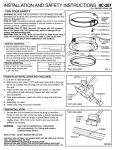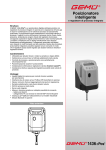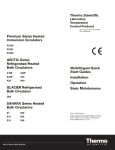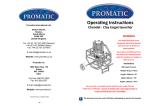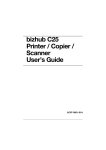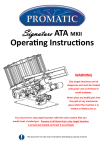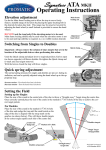Download Operating Instructions Merlin - Clay target launcher
Transcript
Promatic International Ltd. Station Works, Hooton, South Wirral CH66 7NF, United Kingdom. Tel: +44 (0) 151 327 2220 (General) +44 (0) 1407 860800 (Sales) Fax: +44 (0) 151 3277075 E-mail [email protected] Website: www.promatic.co.uk Operating Instructions Merlin - Clay target launcher WARNING Clay target launchers can be dangerous and must be treated with great care at all times to avoid accidents. Never place any bodily part into the path of any mechanical piece whilst the machine is in motion or likely to be so. Promatic Inc. Specifications: 7803 West Hwy 116 Gower MO 64454 USA. 150 target Carousel. Weight: 42.5 kg / 94 lbs Length: 527mm / 20 ½“ Toll Free: 888.767.2529 Fax: 816.539.0257 Width: 440mm / 17¼ “ E-mail: [email protected] (On tilt base) Website: www.promatic.biz Merlin Version 121.4 July 2013 Height: 635mm / 25” You must treat a clay target launcher with the same caution that you would treat a loaded gun. Assume at all times that a clay target launcher is armed and loaded and treat it accordingly This document must be read in full before attempting to operate the machine Preface: Every effort has been made to ensure that the information contained within this manual is complete, accurate and up-to-date. Promatic International assumes no responsibility for errors beyond its control. Conventions used within this manual: Trap: Your Merlin - Clay target launcher—commonly known as a clay trap and may be referred to in this manual as “The trap” or “The machine” Warnings & Cautions: Warning: This section contains instructions which, if ignored or carried out incorrectly, may result in risk of personal injury. Caution: This section contains instructions which, if ignored or carried out incorrectly, may result in malfunction or damage to the equipment Note: This section contains additional information which the user may find useful, but is not essential to the operation of the product. 12v DC Power Source: This product is designed to be powered from a 12v DC battery, it SHOULD NOT BE DIRECTLY CONNECTED TO HOUSEHOLD AC POWER Battery: Where a trap is connected to any other suitable power source i.e. a Transformer - the relevant sections of instructions should still be observed, i.e. “Disconnect the battery” and applied to this or any other power source. EYE PROTECTION MUST BE WORN WHEN WORKING ON OR AROUND A CLAY TARGET LAUNCHER AS SMALL SHARP PIECES OF CLAY MAY BE EJECTED DURING NORMAL USE. 2 11 Understanding your new trap: Spare Parts List: For parts not listed please call Promatic or you local dealer / service agent. Throwing Arm PLASTIC KNOB D01V/100513 THROWING ARM ML/2010 CASTING PLATE HB/3100 Roller Switch Main Shaft Gearbox block CAROUSEL SHAFT HR2/3015 TOP PLATE SPACER ELC/3030 MAIN SHAFT HB/2600 CAROUSEL (UK CLAY) CAR/A4 CAROUSEL (USA CLAY) CAR/A5 PUSHER CLAMP REAR PUSHER TOP HALF ML/1180 PUSHER BEARING SPRING BUSH HB/2635 CLIP ML/2803 GULL-WING BRACKET A28F/PAGC Spring Motor BACK RAIL HR2L/3440 Spring Adjustment Handwheel Carousel CRANK ASSEMBLY ML/2800 Casting Plate Knife edges MAIN SPRING S01Z/FFLY ROLLER LIMIT SWITCH E11V/83850 BATTERY 22Ah SEALED AGM TYPE E30V/SLC22 SOFT FALL PLATE A28S/PAFQ 10 Rear Pusher MOTOR & GEARBOX M01V/50492E Elevation Adjustment Handwheel 3 WARNING BEFORE ADJUSTMENT (Arm timing) Part of this procedure requires you to work very close to the trap - before proceeding be sure you understand and have practised the procedure for putting the trap into safe mode (this can be found on page 6 of this manual) and fully understand when the trap is safe and when it is not. Connecting the battery: Ensure you are behind the machine, the ARM/DISARM switch is in the OFF position and it is otherwise safe to proceed. Connect the red cable to the Red (+) terminal and the black cable to the Black (-) Terminal. Ensure the terminal fasteners are tight, the battery is securely strapped to its tray and the charger has been removed. Adjustment: Throwing arm timing Never approach the machine from the front or sides, Do not assume the trap is safe even without electrical power it may still be armed. Perform the Safe Mode Procedure, Using the Disarm/Nudge button move the motor crank arm to a position just past the straight ahead position. If the block goes too far, rearm the machine (fire it) and then disarm again, repeating the procedure until the desired position is achieved. (The ideal position is such that when the spring crank arm is pointing straight ahead, the motor crank prevents any further movement of the arm.) Push the Throwing arm around until the spring crank arm points directly forward. Disconnect the battery at this point. Loosen the arm clamp block and rotate the arm so the front of the yellow friction strip lines up with the centre of the second bolt head on the gull wing bracket (on the Merlin) (The right hand bolt head when viewed from the rear of the machine) Re-tighten the arm clamp block firmly. Your trap is now correctly timed. Electrical Troubleshooting : Trap fails to re-arm - after a period of prolonged use the trap fails to re-arm itself and is found to be stalled (may also be making a humming sound) then this is an indication that the battery is depleted, and the voltage has fallen too low to operate the trap. Disconnect the battery immediately and re-charge (or fit a replacement fully-charged battery). Although the battery may appear to have recovered, the trap should not be used any further than necessary to make it safe as this may cause damage to the motor, Battery or other electrical circuits. Trap fires by itself - Disconnect any external cable and switch the trap back on. If the trap arms normally then the command cable is faulty. If the trap continues to fire, switch the machine off and disconnect the battery. Check the roller switch is moving freely and an audible click can be heard when it is moved. Re-test the machine. If the machine still fires by itself then the Roller switch is faulty and must be replaced. Circuit breaker has operated - The battery may have been incorrectly fitted (terminals reversed) or an excessive amount of current was drawn either due to a fault or obstruction within the trap. If the circuit breaker has tripped due to an obstruction DO NOT ASSUME THE TRAP IS SAFE it may still be armed with the obstruction holding back the energy from the spring - carefully clear the obstruction whilst remaining in the safe area behind the trap BE AWARE of the path of the throwing arm AND the debris that may be ejected. 4 Gull wing Bracket Timing Position (Over bolt) Crank arm Arm clamp block bolt 9 ALWAYS disarm the machine before carrying out loading, adjustment or maintenance. Positioning the machine 1. Adjustment: Spring Tension Spring adjustment is always easier if the spring attachment point is at its rearmost position, this relieves the spring of a large proportion of it’s tension making adjustment much easier as well as reducing wear on the spring adjustment mechanism. To achieve this, first perform the Safe Mode Procedure (see page 6) to put the machine into safe mode and then nudge forward until the throwing arm projects forward from the front of the machine. At this point stop nudging and disconnect the battery. 2. 3. Clay Target Launchers must be situated on firm level ground in a position that will allow unrestricted access to rear of machine. There must be no obstructions to the path of the throwing arm. Ensure that the power supply can be easily disconnected and cables cannot become tangled in any part of the mechanism. 4. Firing the machine 1. 2. 3. Turn the ON/OFF or switch (if fitted) to the ON or position and set the ARM/DISARM switch to the ARM/LOAD position. The machine will move automatically and arm itself ready to launch a loaded clay. Press the FIRE button on the command cable to throw a clay. The machine will fire every time the FIRE button is pressed and will automatically rearm itself, until disarmed and switched off or disconnected. Disarming the machine 1. 2. Decrease tension—Using the handwheel loosen spring to desired position. Hand tighten inside nut to back of frame and clamp with a further turn of the handwheel. Increase tension—Loosen handwheel one turn, then adjust the inner nut to allow the spring room to pull back. Using the handwheel tighten spring to desired position. Hand tighten inside nut to back of frame and clamp with a further turn of the Important: leave 30mm (1 3/16”) thread length between inside nut and spring coil. Increasing spring tension up to full length of thread will seriously detriment the performance of the machine and will cause spring damage or failure. 8 To disarm the machine push the ARM/DISARM switch upwards to the DISARM position and immediately release (long enough for the trap to fire, but not giving the machine a chance to rearm). Turn the ON/OFF or switch (if fitted) to the ON or position and disconnect the battery. Ensure the machine is stable on firm level ground before use. Bolt the machine to a solid base or the Optional Trolley Base. ALWAYS disarm the machine before any loading, adjustment or maintenance. ALWAYS load clays from rear and ONLY if the machine is disarmed and safe. NEVER approach the machine from the front or sides. ALWAYS from the rear. NEVER allow children or untrained persons to approach or touch the machine. NEVER move an armed/loaded machine. ALWAYS disarm and disconnect battery. REMOVE the main throwing spring before Transport in a vehicle. BE AWARE of the fall zone of both broken and unbroken clays and that a change in wind direction will affect this. 5 Safe Mode Procedure - Warning: Stand at rear of machine only 1. Disarm the machine by flicking the ARM/DISARM switch upwards towards the DISARM position and immediately releasing (long enough for the trap to fire, but not giving the machine a chance to rearm). The Gearbox block (A rectangular block attached to the gearbox shaft) should stop in a position pointing towards the front of the machine. 2. If the Gearbox block is pointing directly towards the front of the machine, push the ARM/DISARM switch momentarily in direction of DISARM/NUDGE just enough to allow the block past its forward pointing position. 3. If the block has gone too far, rearm the machine and then disarm again until the desired position is achieved. ALWAYS disarm the machine before carrying out loading, adjustment or maintenance. Adjustment: Elevation Setting Elevation angle Trajectory of clays are from approximately 26 - 50 degrees. Loosen handwheel nut as shown, tilt to desired angle, re-tighten handwheel . 4. Disconnect the battery/power source from the machine once the block is in the correct position. 5. With the Gearbox block now pointing just past the forward pointing position, the throwing arm can be pushed slowly, USING THE PALM OF THE HAND ONLY, around counter clockwise . Be aware that if machine is already tilted upwards, when the handwheel is subsequently undone the machine will jolt forward. Support the weight of the machine from the top of the carousel when adjusting the elevation angle. 6. As the throwing arm gets to the firing position (pointing direct to the back of the machine) the spring will take over, at which point the drive bolt on the Gearbox block stops the arm, and prevents it from firing. This is SAFE MODE the arm is now trapped between the drive bolt in one direction and locked on the one-way bearing within the trap, it cannot move or release again until power is applied and the ARM/DISARM switch operated. Adjustment: Setting up knife edges The trap has been factory set to a standard Promatic clay , however it may be necessary to re-adjust the knife edges to suit the differing thickness of clay targets from different manufacturers. Place one clay target on the top plate of the machine and slide it half way under the two knife edges. Using a 10mm spanner/wrench, adjust the height of the inner and outer leading edge of each blade. It is desirable to have no less than 0.5mm clearance between the underside of the knife blades and the horizontal shoulder of the clay. 6 7









